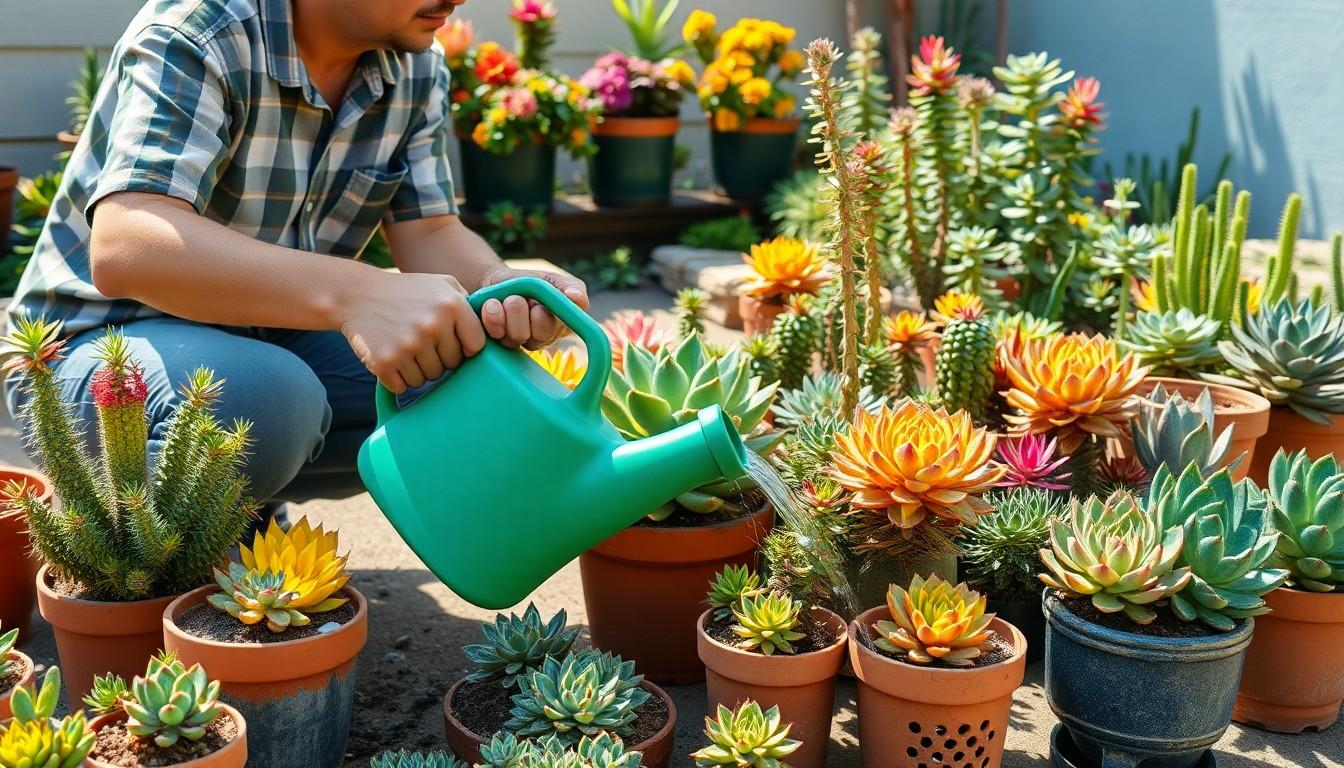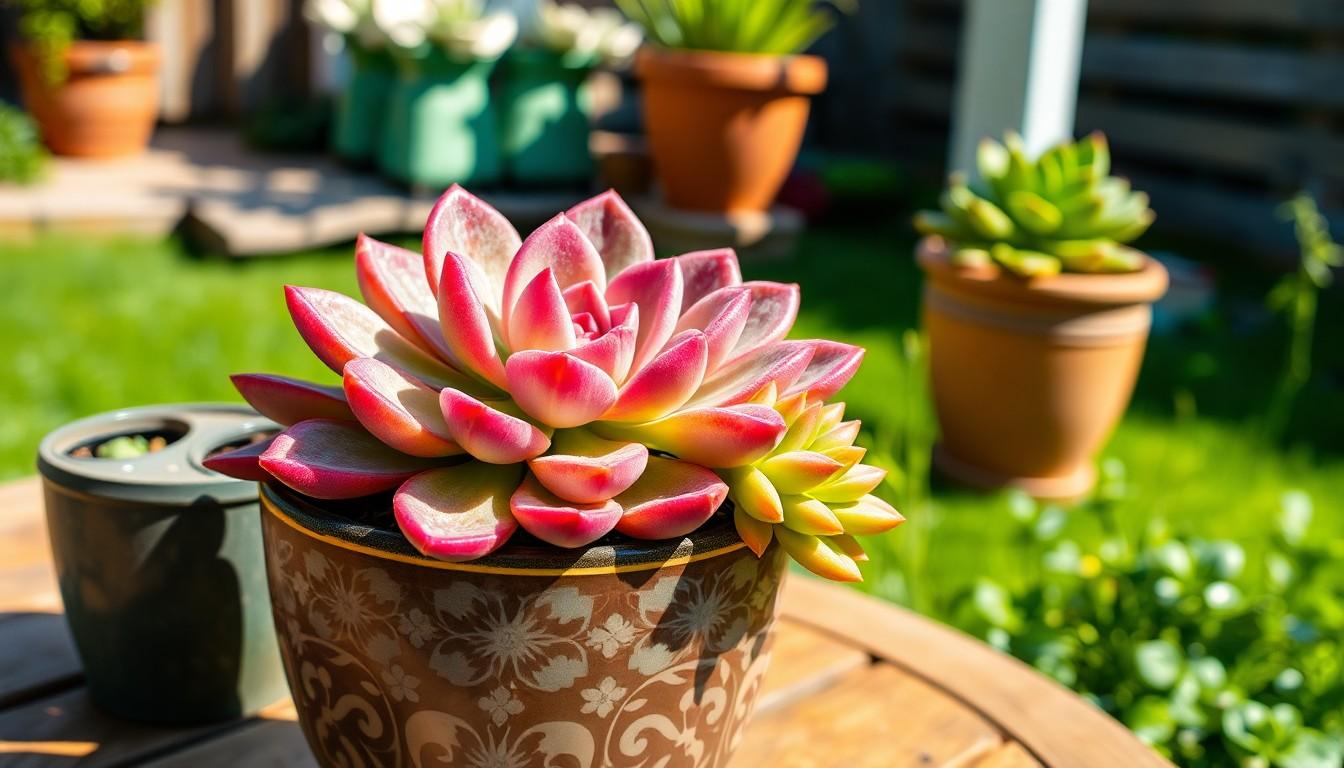Succulents are the charming little green companions that can brighten up any space. With their quirky shapes and vibrant colors, they’re practically begging for attention. But here’s the kicker: they’re not as low-maintenance as they seem. Watering them the right way is crucial, and that’s where many plant parents go astray. Overwatering can turn these adorable plants into mushy messes faster than you can say “drought tolerant.”
Understanding Succulent Needs
Succulents thrive in specific conditions. Knowing their water requirements ensures proper care.
Water Requirements
Most succulents prefer deep, infrequent watering. Soil drainage plays a crucial role in this process. Allowing the top inch of soil to dry out between waterings promotes healthy root growth. Watering during the early morning or late afternoon can minimize evaporation. Monitoring the moisture levels is essential as different types of succulents may have varying needs. For example, Aloe and Echeveria require less water than Jade plants. Using pots with drainage holes prevents standing water and reduces the risk of rot.
Factors Affecting Watering
Climate influences succulent watering needs significantly. Hot, dry weather increases the frequency of waterings. Indoor conditions such as humidity and temperature also impact moisture retention in the soil. Light exposure affects how quickly the soil dries out; bright, direct light often leads to quicker drying times. Additionally, plant size affects water intake. Larger succulents with more surface area may require more water than smaller varieties. Seasonal changes, like growth patterns in the spring and summer, can also alter watering routines.
Best Way To Water Succulents

Watering succulents correctly is essential for their health. Following specific techniques ensures they thrive.
Deep Watering Technique
Deep watering promotes strong root systems in succulents. Watering should occur until it drains from the bottom of the pot. This method encourages roots to search deep into the soil for moisture. It’s crucial to check that drainage holes are clear before watering. Ensuring well-draining soil also aids in preventing root rot. Use this technique when the top inch of soil feels dry to the touch for optimal results.
How Often To Water
Watering frequency depends on environmental conditions and succulent types. Generally, every 1 to 3 weeks suffices for most succulents. During the growing season, increased watering may be necessary, while winter often calls for a reduction. Monitor humidity levels; higher humidity usually requires less frequent watering. Individual plants may show signs of thirst, such as wrinkled leaves, indicating the need for water. Adapting to seasonal changes is key for maintaining healthy succulents.
Common Mistakes To Avoid
Avoiding common mistakes ensures the health of succulents. Small oversights can lead to major issues.
Overwatering
Overwatering remains the most frequent mistake. Soft, mushy leaves signal too much moisture. Root rot often results from excessive water at the base. It’s crucial to use well-draining soil to prevent water accumulation. Checking soil moisture before watering is advisable. A simple finger test ensures the top inch of soil is dry. Adapting watering frequency based on seasonal changes also helps. During hot weather, increased evaporation may necessitate more frequent checks. Monitoring the pot’s drainage holes prevents blockage and excessive moisture around roots.
Underwatering
Underwatering also poses significant risks. Plants exhibit signs of thirst with wrinkled or shriveled leaves. Timely watering becomes essential when this happens. Succulents prefer deep watering that encourages strong root systems. Watering the soil until it drains from the bottom strengthens roots. Keeping a consistent schedule aids in maintaining hydration. Light conditions and temperature directly influence watering needs. Bright, direct light prompts quicker soil drying, making it necessary to adjust the frequency accordingly. Noting seasonal changes helps determine appropriate hydration patterns for healthy succulents.
Signs Of Healthy Succulents
Observing specific signs indicates healthy succulents. Recognizing these indicators helps ensure proper care.
Leaf Texture and Color
Leaves appear plump and firm in healthy succulents. Vibrant colors like greens, reds, or even blues indicate vitality. A dull or discolored appearance often signifies stress from overwatering or underwatering. Healthy succulent leaves should display no blemishes or signs of rot. Leaf texture should feel smooth and a bit waxy, reflecting resilience. For instance, Echeveria usually showcases beautifully colored leaves, while Aloe vera exhibits a healthy green tone.
Growth Patterns
Robust growth patterns characterize healthy succulents. New leaves and stems emerge, suggesting a thriving plant. While some species grow upright, others may spread out; either growth direction indicates health. Stunted growth or excessive leggy stems signals the need for adjustments in care, particularly regarding light exposure. During the growing season, growth should be more pronounced. Regular growth coupled with means of propagation demonstrates a succulent’s vitality and adaptability.
Conclusion
Caring for succulents requires a balance of attention and understanding. By mastering the art of watering and recognizing individual plant needs, it’s possible to cultivate thriving succulents that enhance any space. Monitoring soil moisture and adjusting watering habits based on environmental factors can prevent common pitfalls like overwatering and underwatering.
With the right techniques in place, gardeners can enjoy the beauty and resilience of these unique plants. Healthy succulents not only brighten homes but also provide a sense of accomplishment for their caretakers. Embracing these practices ensures that succulents remain vibrant and flourishing for years to come.

